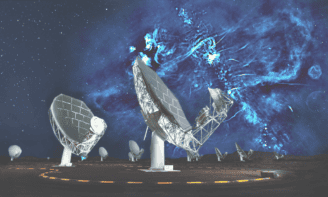
South Africa has inaugurated a new optical telescope that will scan the southern sky for supernovae and other extreme events. The 65 cm MeerLICHT (meaning “more light” in Dutch) telescope, which features a 110 megapixel camera, was inaugurated in late May at the South African Astronomical Observatory, near Sutherland.
The telescope will team up with the MeerKAT radio-telescope array – the country’s precursor to the Square Kilometre Array, which is currently being built – to search for cosmic explosions in both the radio and optical data and get a better understanding of the physics of these energetic events.
“Such a coupling of an optical telescope to a radio telescope has not been done before on this scale,” says Patrick Woudt, co-principal investigator of the MeerLICHT telescope, who is based at the University of Cape Town. “To match the wide field of view of the MeerKAT telescope, we required a special optical design of the telescope, which gives us nearly three square degrees on the sky with a single detector.”
Developing human capital and multi-wavelength astronomy is a great strategy
Arvind Vimal Ramessur
Woudt adds that MeerLICHT will also serve as a prototype for an array of three similar telescopes that will be placed at an observatory in Chile to search for optical counterparts of gravitational waves.
A better perspective
Arvind Vimal Ramessur, an astronomer based at the Hartebeesthoek Radio Astronomy Observatory near Johannesburg, who is not part of the project, says the launch of MeerLICHT is another milestone in astronomy, especially for Southern African astronomers and engineers. “Observations of the sky made with different wavelength will give us a better perspective and provide us with additional information of any sources of interest,” he says. “Developing human capital and multi-wavelength astronomy is a great strategy. Such endeavours mean more training programmes and projects for our young Southern African graduates to pursue research in astronomy and engineering.”
The MeerLICHT consortium is a collaboration between the European Research Council, the Netherlands Research School for Astronomy, Netherlands Organisation for Scientific Research, South African Astronomical Observatory and the universities of Amsterdam, Cape Town, Manchester, Oxford and Radboud Nijmegen.



